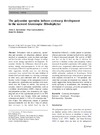Please use this identifier to cite or link to this item:
https://accedacris.ulpgc.es/handle/10553/1050
| Title: | The polyamine spermine induces cystocarp development in the seaweed Grateloupia (Rhodophyta) | Authors: | Sacramento Trujillo, Alicia García-Jiménez, Pilar Robaina, Rafael R. |
Keywords: | Enzimas Algas rojas Poliaminas |
Issue Date: | 2007 | Project: | Mecanismos Moleculares Responsables de Los Efectos de Las Poliaminas Sobre la Reproduccion y El Estres Salino en Macroalgas | Journal: | Plant Growth Regulation | Abstract: | Polyamines such as putrescine, spermidine and spermine are ubiquitous aliphatic amines involved in reproductive events in plants and algae, and first become evident through changes in endogenous levels during reproductive development. To examine whether the differences observed in polyamines, during carposporogenesis, in the red alga Grateloupia, followed a specific pattern as is seen in other organisms, infertile axes (i.e. not showing cystocarps) were excised from the same holdfast of female fertilized individuals (i.e. showing cystocarps in other axes), and cultivated until the cystocarps became visible. Changes in the endogenous levels of free putrescine, spermidine and spermine were monitored over the 8 days of culture. The activity of enzymes related to polyamine metabolism, such as L-ornithine decarboxylase (ODC), diamine oxidase and polyamine oxidase, was measured at the beginning and end of the experimental period. Up to 50% of the infertile axes became fertile and produced cystocarps at a density of 1.91 ± 0.1 cystocarps mm2 after 8 days. The endogenous content of spermine increased markedly over the first 5 days of culture, then decreased to the initial level by day 8. Spermidine followed a similar pattern to spermine, whereas putrescine remained at high levels, until day 5 when it decreased abruptly. The activity of ODC was less on day 8 than on day 0, whereas the activities of diamine oxidase and polyamine oxidase increased. In parallel experiments with explants from infertile axes, exogenously added spermine (106 M) increased the number of cystocarps, and reversed the effect of cyclohexylamine (CHA), which is known to inhibit polyamine synthesis in Grateloupia. Serial sectioning and microscopic observation of specimens from explants cultivated in 106 M spermine indicated that cystocarp development was induced. The results suggest that, during transition from infertile to fertile spermine is accumulated, thus favouring the development of cystocarps, given the presumed role of spermine as an inducing agent. | URI: | https://accedacris.ulpgc.es/handle/10553/1050 | ISBN: | 1676903 | ISSN: | 0167-6903 | DOI: | 10.1007/s10725-007-9212-0 | Source: | Plant Growth Regulation[ISSN 0167-6903],v. 53, p. 147-154 |
| Appears in Collections: | Artículos |
SCOPUSTM
Citations
30
checked on May 18, 2025
WEB OF SCIENCETM
Citations
31
checked on May 11, 2025
Page view(s)
157
checked on Mar 15, 2025
Download(s)
382
checked on Mar 15, 2025
Google ScholarTM
Check
Altmetric
Share
Export metadata
Items in accedaCRIS are protected by copyright, with all rights reserved, unless otherwise indicated.
